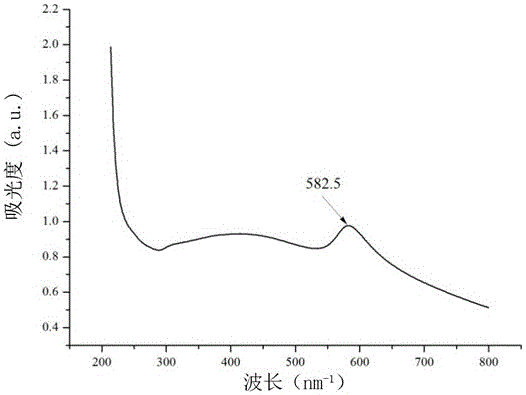Efficient preparation method for nano-copper particles with hydroxypropyl methyl cellulose as protective agent
A technology of hydroxypropyl methylcellulose and nano-copper particles, applied in nanotechnology, metal processing equipment, transportation and packaging, etc., can solve problems such as inability to apply large-scale production well, waste of human and material resources, etc., and achieve Effects of reducing waste, low cost, and wide application prospects
- Summary
- Abstract
- Description
- Claims
- Application Information
AI Technical Summary
Problems solved by technology
Method used
Image
Examples
Embodiment 1
[0031] Weigh 0.1 g of hydroxypropyl methylcellulose, add it into a 250 mL three-necked flask, add 15 mL of deionized water, dissolve it under magnetic stirring, and make a hydroxypropyl methylcellulose solution;
[0032] Weigh 0.05 g of copper sulfate pentahydrate and add it to a 50 mL beaker, add 5 mL of deionized water, and dissolve it under magnetic stirring to form a copper sulfate solution;
[0033] Pour the prepared copper sulfate solution into the three-necked flask containing the hydroxypropyl methylcellulose solution, and stir magnetically for 10 minutes to mix the two evenly to obtain a mixed solution of hydroxypropyl methylcellulose-copper sulfate;
[0034] Measure 3 mL of 50% hydrazine hydrate, add it to a 50 mL beaker, and add 10 mL of deionized water to make a hydrazine hydrate solution with a mass concentration of 0.115 g / mL;
[0035] Under the action of magnetic stirring, the hydrazine hydrate solution was added dropwise to the copper sulfate-hydroxypropyl methyl...
Embodiment 2
[0038] Example 2: Same as Example 1, but the solid hydroxypropyl methylcellulose in step (1) is changed to 0.5 g, and the deionized water is changed to 150 mL.
Embodiment 3
[0039] Example 3: Same as Example 1, but the copper sulfate pentahydrate in step (2) is changed to 0.1 g, and the deionized water is changed to 20 mL.
PUM
| Property | Measurement | Unit |
|---|---|---|
| Particle size | aaaaa | aaaaa |
Abstract
Description
Claims
Application Information
 Login to View More
Login to View More - R&D
- Intellectual Property
- Life Sciences
- Materials
- Tech Scout
- Unparalleled Data Quality
- Higher Quality Content
- 60% Fewer Hallucinations
Browse by: Latest US Patents, China's latest patents, Technical Efficacy Thesaurus, Application Domain, Technology Topic, Popular Technical Reports.
© 2025 PatSnap. All rights reserved.Legal|Privacy policy|Modern Slavery Act Transparency Statement|Sitemap|About US| Contact US: help@patsnap.com



